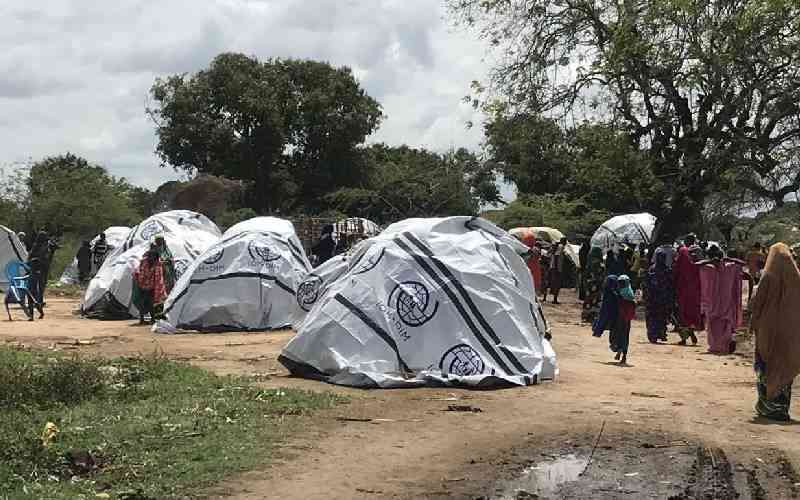From wealth to relief food: How floods have left Tana River families in devastation
Coast
By
Rosa Agutu
| Sep 10, 2024

I slept a rich man, then woke up poor waiting for relief food,” Says 50-year-old Bashir Siyadh who lost all his investments during the floods.
A parent’s dream is to at least provide the basic needs for their children; Food, shelter and clothing. What happens when such needs are not fulfilled? What does it do to a parent’s mind when you lose everything when just a few months ago you had a homestead, children going to school, healthy livestock, and healthy vegetables on the farm?
From sleeping in a warm bed to sleeping on mats in tents. From eating food from your farm to waiting for relief food. This shift can not only interfere with physical but mental wellness.
READ MORE
China Square's Sh1b expansion war chest rattles retail outlets
Pesaflix, one of the first video on demand application to revolutionize entertainment industry
Sony Sugar posts Sh113m profit after a decade of losses
What KNBS numbers reveal about economy in first 2 years under Ruto
CBK faces litmus test in fresh multi-billion-coin minting tender
Kenya tops African venture funding in 2024 with Sh82b
Kenya to legalise cryptocurrencies, says Treasury Cabinet Secretary
Mombasa port handled record 41.1m tonnes of cargo in 2024
KenGen to ramp up geothermal output with Hell's Gate project
“I had wealth that I had accumulated for decades. I knew my future was secure but in a blink of an eye, I went from being financially comfortable to poor. Back to zero,” Says Bashir Siyadh.
We meet Bashir at Marafa village in Tana River County. He is seated with fellow men under a tree. He is among the residents who live in temporary shelters provided by the IOM International Organisation for Migration.
Bashir had 150 goats and sheep and 51 cows left with 16 cows.
“I lost my livestock while crossing to the dry land during the floods. I lost others because I could not find a place to feed them, others died of diseases. My cows have a hard time conceiving or lose the pregnancies because of lack of food, and diseases,” he says
Bashir wishes he had sold his livestock.
“You know when everything happened, I was still in shock. Also trying to make sure everyone is safe but now when the shock is gone, I wish I had sold some of them and kept the money in the bank,” he says
Due to congestion, there was an outbreak of cholera.
“Since there’s no hospital nearby. Red Cross had to come with mobile hospitals to salvage the situation,” he says
“We just want our lives to go back to normal. Permanent houses and medicine for our livestock” says Bashir
Education was also halted for 3 months. Right now the children go to school however, they still struggle because of a lack of food.
Apart from livestock, the floods also affected farmers.
The long rains changed their lives. As the land dried, albeit still risky some of them have decided to go back to their farms and plant, saying, “We cannot wait for relief food. We have families to feed and life has to move on.”
We meet Athman Mohammed Jilo in Gala Mani, Tana River County. Athman also lives in temporary shelters provided by IOM International Organisation for Migration.
We find him near his tent. The Gala Mani temporary shelters are beside the road. Across the road and a few meters down at shore of river Tana is where most residents had their homes and farms.
Athman takes us to his farm, and along the way we see other residents also farming. They have started with maize. Before we reach Athman’s farm a bigger part of the area is covered with mango trees that provide unmatched shade and a slight economic boost when they sell the mangoes.
We finally reach Athman’s farm. He has planted maize and green grams.
“Before the floods, we used to use water pumps. Right now armyworms are our biggest challenge. I have lost two harvests because of the armyworms,” he says
Athamn says when the rains started they were grateful not knowing it would change their lives. Most of them were ready to harvest, but the floods washed away their hard work. They are requesting for farm tools and seeds.
Another resident is 72-year-old Grace Luwa. Luwa is seated with fellow women on a mat outside the temporary shelters.
“I had my vegetables on the farm, but everything was ruined by the floods. I have never struggled looking for food because I had everything I needed on my farm but things changed,” she says.
Armyworms and wildlife are ruining their crops.
“The worms have ruined everything. Some hippos step on the maize and take us back to square one,” she says
Just like Bashir and Athman, Luwa says they do not want to rely on relief food, they want to be equipped so that they can fend for themselves.
“IOM has helped us with non-food items, and we are grateful. But we want to be assisted with pesticides, seeds and farming tools, the rest we can do for ourselves,” Says Luwa
Authorities
The Minister for Health in Tana River County, Joshua Kofa says the cholera outbreak was highly influenced by the congestion.
“We had isolation units. Cholera is a sign of bad sanitation, we partnered with the Ministry of Water, to transport clean water to those areas. We treated the wells and gave them tablets that treat drinking water,” he says
Kofa adds that they did rapid tests before announcing the outbreak. They also sensitized the masses on good sanitation.
A non-governmental organization built toilets made of iron sheets in the camps following the sanitation challenge.
Milka Karai, the Director of Service Delivery Unit in Tana River County says that their main agenda is to ensure the residents are safe.
“We have come up with measures to ensure the residents are aware of early warning signs of disasters. So that we save lives and property,” she says
Head of Programmes at IOM Kenya Sharif Faisal, says the plan is to look for longer-term solutions.
“We have a whole spectrum of stakeholders involved. We are working very closely with the county government. The governor has reached out to partner with IOM. The Tana River government has this cluster approach, where they plan to relocate vulnerable communities to higher ground and create permanent solutions for them; shelter, health facilities, and education. We are discussing with development partners to see what is possible.” He says
On finding permanent solutions, The County Government of Tana River has set aside land for relocating flood victims to higher grounds.
“This undertaking is very expensive because it means moving infrastructural investments like schools, health facilities, and water structures to the new areas. The people have now embraced the programme and slowly it is gaining traction. The County government and some partners have supported through the distribution of building materials and temporary shelter facilities for schools and health facilities and collapsible water tanks,” says County Secretary Mwajuma Hiribae
However, some residents are reluctant to move claiming they cannot farm in the highlands. Joe Mbalu, The Acting Secretary General in charge of Programmes at The Kenya Red Cross, says it’s very difficult to move communities, the decision has to come from them. However, they can farm in the riparian areas but live in the highlands where the cluster villages are.
“There are discussions because this will happen again. There are areas where they can go for farming but keep their families from those areas so that when floods come everyone is safe. We have activated warning protocols, where we monitor and give them real-time information,” he says
Mbalu says they monitor the levels of the monitor so that they can warn the communities in time.

